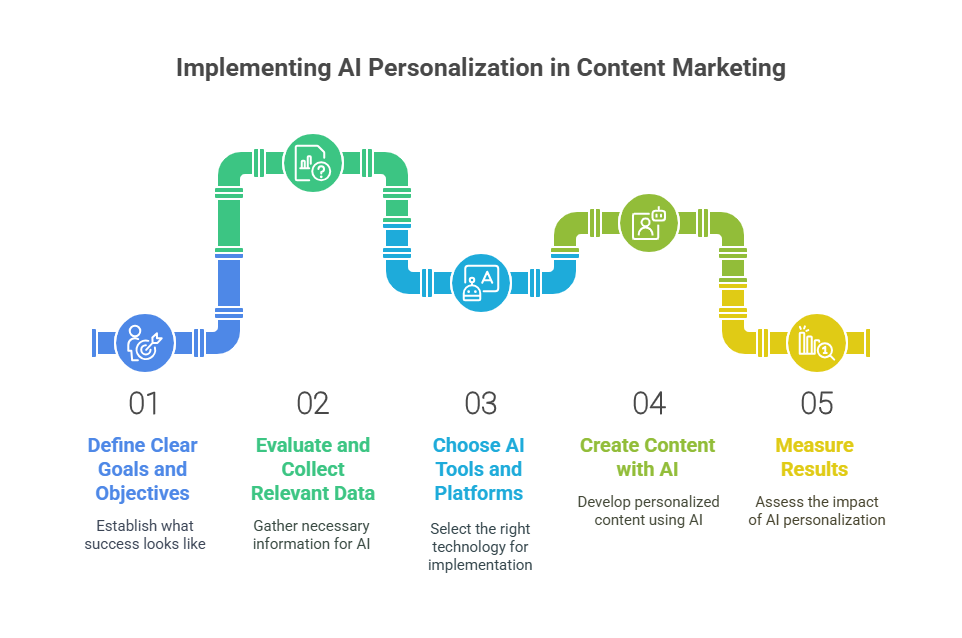How to Implement AI Personalization in Content Marketing
Is your business using AI personalization?
Jump Ahead to Learn:
To busy to read? Listen to the podcast summary. 4 minutes
Introduction to AI Personalization and Content Marketing
In today's ultra competitive digital world, the age of generic marketing messages is dying. Instead, businesses that use the power of personalized content marketing are winning over customers with experiences that feel uniquely crafted just for them. We have heard about the rise of data for years, but we haven’t been able to leverage that data until now.
Looking at your last few months' business, you might have noticed that consumers are no longer satisfied with one-size-fits-all approaches. Recent statistics from Forbes show that 91% of consumers prefer brands that offer personalized experiences. This statistic emphasizes the need for a more nuanced, data-driven approach to content marketing.
This article will walk you through the transformative power of AI-driven hyper-personalization. I’ll break down what it is, why it matters, and how you can implement it in your business.
Whether you’re new to the concept or looking to fine-tune your existing digital marketing strategy, this conversational and practical guide is designed to help you create engaging, content that resonates with your audience on a personal level.
What is AI-Driven Hyper-Personalization?
A Simple Definition
AI-driven hyper-personalization is the use of advanced algorithms and real-time data analysis to create tailored experiences for each customer. This is a fancy way of saying that you need to use internal and external data, combine the data with AI-driven tools to give every one of your potential customers a unique experience.
Unlike traditional personalization, segmenting your target audience by broad demographics like age or gender, hyper-personalization digs deeper. It leverages insights from a customer’s browsing habits, purchase history, and location to deliver content that feels personally relevant.
Traditional vs. Hyper-Personalization
Traditional personalization often relies on static segments. Think of it as grouping your customers into broad buckets and then sending them similar messages. On the other hand, hyper-personalization uses machine learning to adapt in real time.
It tailors your messaging at the individual level, constantly refining profiles based on new data. This means each email, website banner, or social media ad can be different for every customer, maximizing relevance and engagement.
Why It Matters for Businesses
For small and medium-sized businesses (SMBs), the stakes are high. Customer acquisition is often cited as a top challenge, and resources are limited. Here’s why hyper-personalization is a game-changer:
Enhanced Customer Engagement: Personalized emails, for example, boast a 26% higher open rate than generic ones.
Improved Marketing Efficiency: By automating data analysis and content creation, you free up valuable time and resources. Tools that dynamically adapt content can boost your marketing efficiency significantly.
Increased Loyalty and Repeat Sales: When customers feel understood, they are more likely to stick around. Forbes reported that 70% of consumers exhibit higher loyalty to brands that understand their needs.
AI Content Personalization: Understanding the Core Concepts
What is AI Content Personalization?
In basic terms, AI content personalization or AI powered personalization refers to the process of using artificial intelligence to tailor your digital content. Think about all the content that your brand produces. This could be content like website product pages, emails, videos, or paid ads.
When you use AI content personalization, you ensure that this content is specific to the different interests and behaviors of your audiences. By analyzing your data in real time, AI tools can predict what content will resonate best with each individual.
How It Differs from Traditional Methods
Granularity: While traditional methods lump customers into broad segments, hyper-personalization treats each customer as an individual. This level of granularity means your content is not just relevant but truly personal.
Real-Time Adaptation: AI systems continuously learn from live data, meaning your marketing messages can adjust to reflect a customer's current behavior or context.
Predictive Capabilities: With machine learning, you’re not only reacting to customer behavior, you’re anticipating it. This proactive approach can guide customers along their buying journey more effectively.
Why This Matters for Your Business
For SMBs, every marketing dollar counts. AI-driven hyper-personalization means you’re targeting only those people who are most likely to convert, reducing wasted efforts and maximizing your ROI.
In a world where customer attention is fleeting, this precise targeting can make all the difference.
Personalized Content Marketing: The Benefits of Hyper-Personalization
Higher Conversion Rates and ROI
Businesses leveraging hyper-personalization report a 20% increase in sales conversions on average. This boost comes from AI’s ability to predict customer intent. Imagine suggesting a travel package based on past vacation bookings, or showcasing a product similar to one a customer recently purchased. These targeted recommendations simplify the decision-making process, resulting in quicker conversions.
Greater Customer Satisfaction and Brand Loyalty
When your customers receive content that speaks directly to their needs and preferences, their overall experience improves. This loyalty can translate into repeat sales and word-of-mouth referrals, both of which are critical for sustained business growth.
Reduction in Wasted Marketing Efforts
Traditional "spray-and-pray" tactics often result in wasted resources on audiences that aren’t interested in your offerings. With AI-driven targeting, you only reach those who have shown signs of interest.
Proactive Customer Retention
Using predictive analytics, AI can identify at-risk customers even before they decide to leave. By sending timely, personalized re-engagement messages, you can retain customers who might otherwise churn, ensuring a steady revenue stream over time.
Common AI Techniques in Hyper-Personalization
Predictive Analytics
Predictive analytics involves using historical data to forecast future behaviors. Imagine knowing when a customer is most likely to make a purchase or when they might need a reminder about an abandoned cart. This foresight enables you to intervene at just the right moment, improving your chances of conversion. For example, a boutique might use predictive analytics to anticipate seasonal demand spikes, ensuring they always have the right stock.
Natural Language Processing (NLP)
NLP from large language models helps AI understand and interpret human language. This technology is crucial for deciphering customer sentiment from online reviews, social media posts, and even chat conversations. With tools like GPT-4.5, AI can generate responses that are contextually aware, enhancing the quality of your customer interactions. This capability has led to improvements in customer service resolution rates by as much as 40%.
Dynamic Content Generation
Dynamic content generation uses generative AI (GenAI) to create unique content on the fly. Whether it's crafting tailored email subject lines or generating personalized product descriptions, this technology enables you to scale your content marketing efforts without sacrificing quality.
A prime example is Airbnb, which customizes property listings in real time based on a user’s previous searches and budget constraints.
How to Implement AI Personalization in Content Marketing: A Practical Guide for SMBs
Now that you understand the power of AI-driven hyper-personalization, let’s dive into a step-by-step guide on how you can implement these strategies in your own business.
Step 1: Define Clear Goals and Objectives
Before you jump in, it’s crucial to set clear goals. Start small by choosing one channel to focus on. Whether it's email campaigns, website personalization, or social media engagement.
For instance, you might set a goal to increase your email open rates by 25% within three months or to reduce cart abandonment through personalized product reminders. Establishing measurable objectives will help you track your progress and adjust your strategy as needed.
Step 2: Evaluate and Collect Relevant Data
Data is the backbone of hyper-personalization. To begin, focus on collecting three main types of data:
Demographic Data: Basic information such as age, gender, and location.
Behavioral Data: Data that shows how customers interact with your website. This could be pages visited, time spent on site, click-through rates, etc.
Transactional Data: Details about customer purchases, average order value, and frequency of transactions.
Tools like Google Analytics and CRM platforms are excellent for gathering this data without requiring deep technical expertise. Even if you’re just starting, ensure your data is clean and well-organized, as this will directly impact the effectiveness of your AI models.
Step 3: Choosing Beginner-Friendly AI Tools and Platforms
For many SMBs, diving into complex AI systems can feel overwhelming. Fortunately, there are several beginner-friendly platforms designed with non-tech experts in mind. Here are a few recommendations:
Chatfuel: A no-code chatbot builder that can help you automate customer interactions on platforms like Facebook Messenger.
HubSpot: Known for its AI-powered email segmentation and dynamic content tools, HubSpot is ideal for businesses looking to dip their toes into hyper-personalization.
Dynamic Yield: A platform that personalizes website experiences based on user behavior, making it perfect for SMBs looking to improve on-site engagement.
When selecting tools, consider factors like cost, ease of integration with your existing systems, and the level of customer support offered. For example, entry-level tools often start at around $50/month, which is manageable even for smaller budgets.
Step 4: Content Creation and Delivery Using AI
One of the greatest advantages of AI-driven personalization is its ability to generate content at scale. By harnessing the power of machine learning algorithms, it is easier to go fast, adapt, and scale.
However, it’s important to strike a balance between automation and human oversight. Here’s how:
Leverage AI for Initial Drafts: Use AI to create email subject lines, blog post outlines, or product descriptions. Tools like ChatGPT can generate ideas quickly.
Maintain Human Touch: Always review and adjust AI-generated content to ensure it aligns with your brand’s voice and messaging. For instance, a bakery might use AI to generate holiday-themed promotions but then tweak the copy to include local idioms or unique selling points.
Test and Iterate: Run A/B tests with different versions of your AI-generated content to see which performs best. This data will help you improve your campaigns.
Step 5: Measuring and Analyzing Your Results
To know if your efforts are paying off, you need to monitor the right metrics. Focus on:
Click-Through Rates (CTR): Indicates how many people are engaging with your content.
Conversion Rates: The percentage of visitors who complete a desired action, like making a purchase or signing up for a newsletter.
Customer Lifetime Value (CLV): Helps determine how much revenue you can expect from each customer over time.
Engagement Metrics: Such as time spent on your site and bounce rates.
Use these metrics to interpret your data and adjust your strategies. Regular A/B testing and continuous optimization will ensure your hyper-personalization efforts are always evolving to meet customer needs.
Conclusion
With the rise of “for you” channels on social media. Consumers now expect experiences tailored to their individual needs, AI-driven hyper-personalization is not just an option, it’s a necessity for modern businesses. By embracing this technology, you can enhance customer engagement, boost conversion rates, and ultimately drive sustained growth.
For SMBs, starting with a pilot campaign can be a smart way to dip your toes into hyper-personalization. Begin with one channel, perhaps your email marketing, and gradually expand as you learn what works best for your audience. With the right tools, a focus on clean data, and a commitment to continuous improvement, you can transform your marketing strategy into one that not only meets but exceeds customer expectations.
The future of content marketing is hyper-personalized. Using the power of AI you now have the opportunity to deliver truly unique experiences that set your brand apart.



